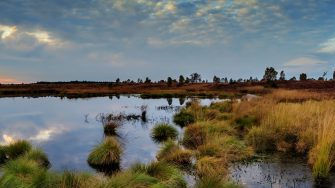
Date: Thursday, October 7, 2021
Project: Eastern Australian Waterbird Survey
Observers: Richard Kingsford & John Porter
Pilot: James Barkell
On an overcast day, we headed north out of Bourke, towards survey band 6 over the Queensland border, where we finished the day before, just near the Queensland town of Dirranbandi. This meant flying up the Darling River until we met the Culgoa River, one of the northern tributaries of the Darling.
It is here where there is a channel built to divert water from the Culgoa River to the enormous Cubbie Station irrigated cotton farm, which can store about a Sydney Harbour’s worth of river water. The channel built to divert water from the river is even bigger than the Culgoa River’s natural channel, obscured by its overhanging coolabah trees, as it flows south to meet the Darling River.
We then headed west on our survey. This year the country looked in great shape with all shades of green dominating a landscape which is so often full of greys. The flying conditions, with no wind and overcast, were perfect. We crossed the Nebine River, with a thin ribbon of water and no waterbirds, before getting to the Warrego River. It only had a few patches of water in the main channel.
Here on the Warrego, there is one of the few off-river storages on this river, where water is diverted into a large constructed wetlands. As nearly always, there was only the odd waterbird on the waterbody. Waterbirds just don’t have enough food to eat in these artificial wetlands, unlike natural wetlands.
Just south of Cunnamulla as we headed west, there are lots of small claypans and canegrass swamps, many of which held water last year. It took us a fair while to survey them in 2020. But this year, only a handful had water with a few pink-eared ducks, Pacific herons and grey teal. We then flew west to the next river – the Bulloo River.
This is one of our favourite rivers. It is not only very picturesque but also is one of the few largely free flowing rivers that we have, with very little river extraction. As a result, it is super healthy from an ecological point of view, flowing almost directly west. This river then heads south and pours out on a massive floodplain, called the Bulloo Overflow. It first fills the magnificent two Bulloo Lakes in Queensland. These are two substantial lakes, surrounded on the northern part of the floodplain by well established lignum, an aquatic shrub which supports waterbird nests. The two lakes have water more often than they don't, largely because they get topped up by small and large flows from the Bulloo River.
Even though the lakes had quite a bit of water this year, there were relatively few waterbirds. This included a few flocks of grey teal, black duck, glossy ibis, and pelicans. There were also up to 50 brolgas which looked great. There weren’t the thousands of waterbirds that we can see on these two lakes.
We then headed southwest over the New South Wales border, over the new Narriearra National Park which is a continuation of the Bulloo River. In big floods, the Bulloo River spills over into NSW and the National Park, flooding under and through the dingo fence that separates the two states. It sometimes even knocks over the fence.
Our surveys in the late 80s and 90s showed that sometimes this wetland, part of the Bulloo Overflow, can support up to 100,000 waterbirds. It is a wonderful acquisition for NSW protected area system. We finished the day in Tibooburra.
